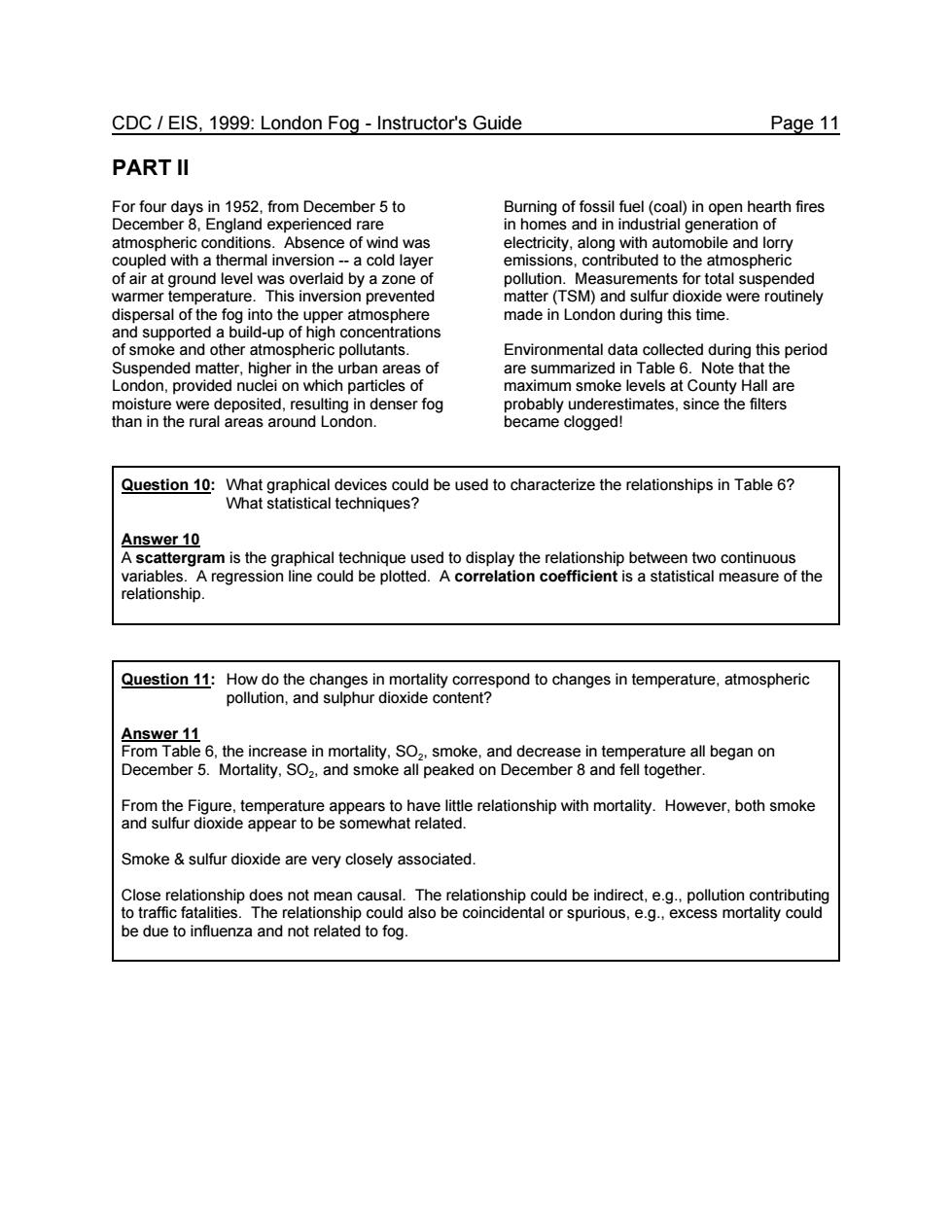正在加载图片...

CDC/EIS,1999:London Fog-Instructor's Guide Page 11 PART II For four days in192,from December5to Burning of fossil fuel(coal)in open hearth fires December 8,England experienced rare in homes and in industrialgeneration of atmospheric conditions.Absence of wind was electricity,along with automobile and lorry coupled with a thermal inversion-a cold layer emissions,contributed to the atmospheric of air at ground level was overlaid by a zone of pollution.Measurements for total suspended warmer temperature.This inversion prevented matter(TSM)and sulfur dioxide were routinely dispersal of the fog into the upper atmosphere made in London during this time ntrations e and Environmental data this perio Suspended matter,higher in the urban areas of are summarized in Table 6.Note that the London,provided nuclei on which particles of maximum smoke levels at County Hall are moisture were deposited,resulting in denser fog probably underestimates,since the filters than in the rural areas around London. became clogged! Question 10:What graphical devices could be used to characterize the relationships in Table 6? What statistical techniques? Answer 10 is the graphical technique used to display the relationship between twocontinuous ables A regression line could be plotted. A correlation coefficient is a statistical measure of the relationship. Question 11:How do the changes in mortality correspond to changes in temperature,atmospheric pollution,and sulphur dioxide content? Answer 11 om Table 6,the increase in mortality,SO2.smoke,and decrease in temperature all began on December 5.Mortality,SO2,and smoke all peaked on December 8 and fell together. From the Figure,temperature appears to have little relationship with mortality.However,both smoke and sulfur dioxide appear to be somewhat related. Smoke sulfur dioxide are very closely associated. Close relationship does not mean causal.The relationship cou be indirect,pollution to traffic fatalities. I he relationship could also be coincidental or spunous,e.g.,excess mortality coulo be due to influenza and not related to fog. CDC / EIS, 1999: London Fog - Instructor's Guide Page 11 PART II For four days in 1952, from December 5 to December 8, England experienced rare atmospheric conditions. Absence of wind was coupled with a thermal inversion - a cold layer of air at ground level was overlaid by a zone of warmer temperature. This inversion prevented dispersal of the fog into the upper atmosphere and supported a build-up of high concentrations of smoke and other atmospheric pollutants. Suspended matter, higher in the urban areas of London, provided nuclei on which particles of moisture were deposited, resulting in denser fog than in the rural areas around London. Burning of fossil fuel (coal) in open hearth fires in homes and in industrial generation of electricity, along with automobile and lorry emissions, contributed to the atmospheric pollution. Measurements for total suspended matter (TSM) and sulfur dioxide were routinely made in London during this time. Environmental data collected during this period are summarized in Table 6. Note that the maximum smoke levels at County Hall are probably underestimates, since the filters became clogged! Question 10: What graphical devices could be used to characterize the relationships in Table 6? What statistical techniques? Answer 10 A scattergram is the graphical technique used to display the relationship between two continuous variables. A regression line could be plotted. A correlation coefficient is a statistical measure of the relationship. Question 11: How do the changes in mortality correspond to changes in temperature, atmospheric pollution, and sulphur dioxide content? Answer 11 From Table 6, the increase in mortality, SO2, smoke, and decrease in temperature all began on December 5. Mortality, SO2, and smoke all peaked on December 8 and fell together. From the Figure, temperature appears to have little relationship with mortality. However, both smoke and sulfur dioxide appear to be somewhat related. Smoke & sulfur dioxide are very closely associated. Close relationship does not mean causal. The relationship could be indirect, e.g., pollution contributing to traffic fatalities. The relationship could also be coincidental or spurious, e.g., excess mortality could be due to influenza and not related to fog